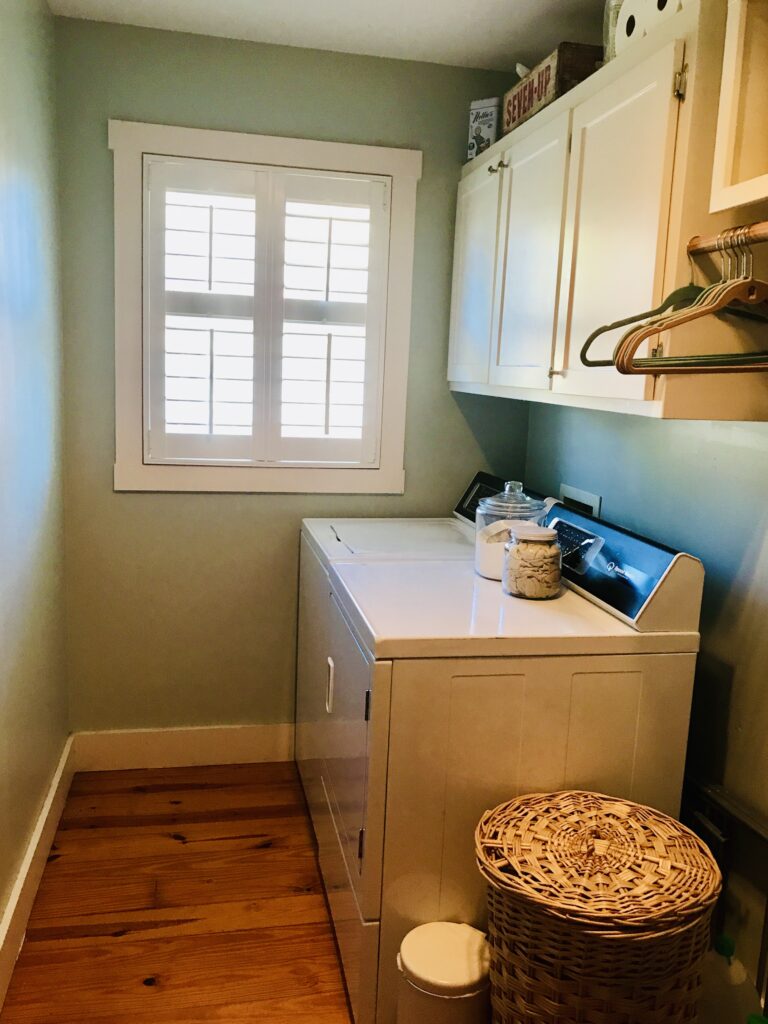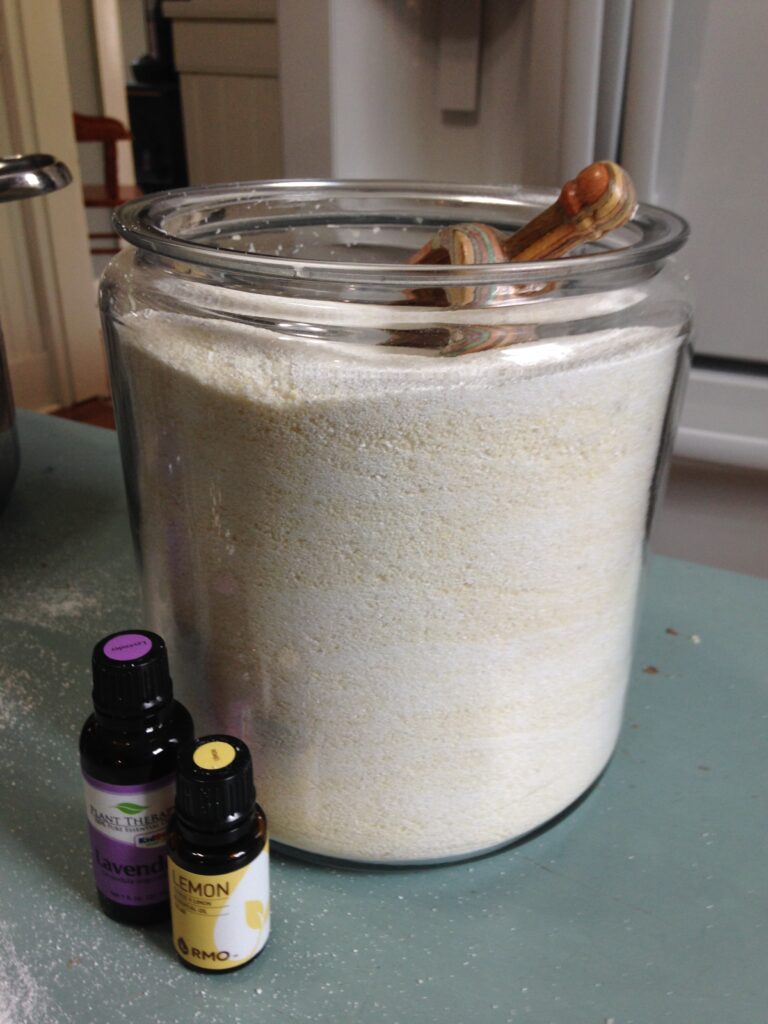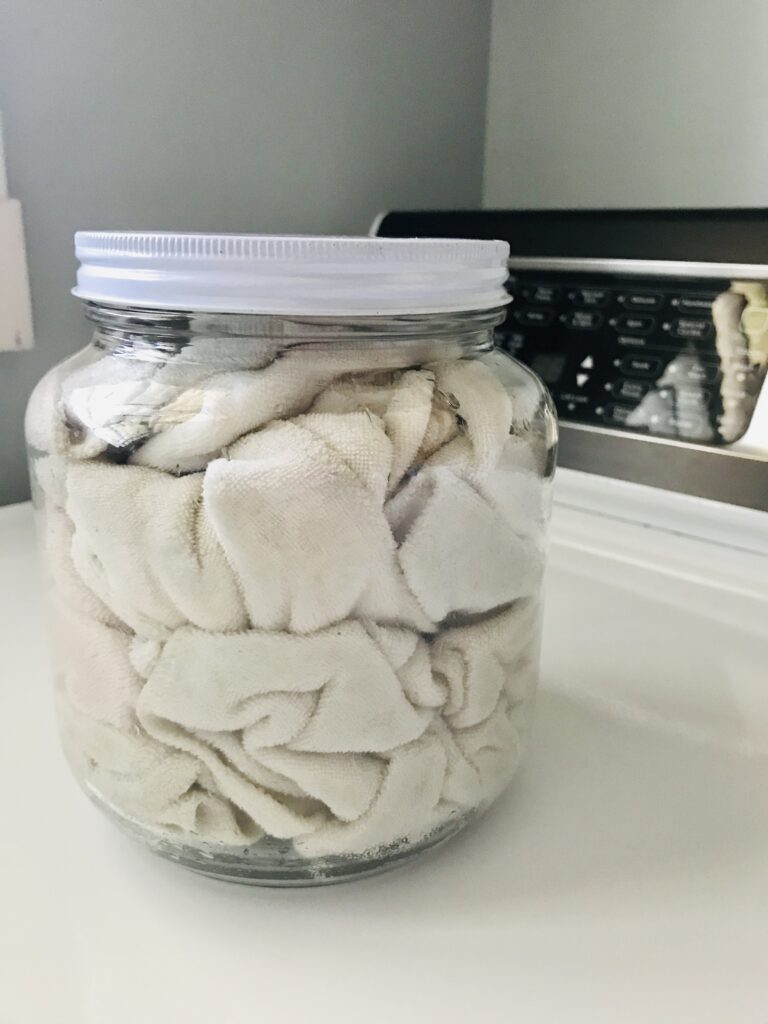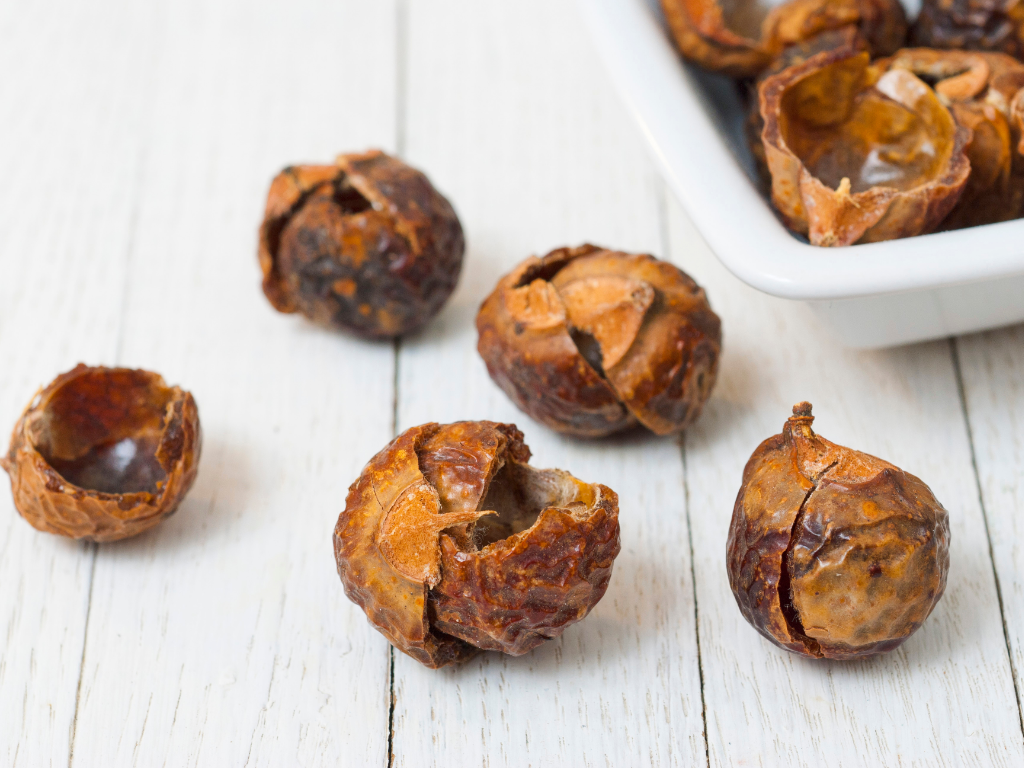EnJOYing the satisfaction of preparing your own laundry soap will not only save you LOADS of money, but will help you gain control of what comes in contact with your family’s skin and clothing. When you involve the kids, you are teaching them the importance of creating a greener, healthier home in a cost effective way.

Ridding the Home of Harmful Toxins
Ever since I had my first child, I have been doing my best to eliminate as many toxins from our home, food, and body care products as possible. Actually, the phrase, “You are what you eat” is kind of a guideline for my choices. I have used that phrase when questioning whether or not to apply a product on my skin or hair, brush with it, clean with it, or eat it. We are an accumulation of all that we come in contact with. The fewer toxins we ingest or have in our environment, the better our bodies can function the way they were designed to. I know I can’t control everything, but eliminating the obvious intruders is a good place to start. Laundry detergent is a HUGE offender because whatever we wash our clothes and sheets with is in contact with our bodies 24/7. Avoid these offenders on the labels of your products and find a better solution for your family:
- Sodium Lauryl Sulfate
- Phosphates
- Formaldehyde
- Chlorine Bleach
- Ammonium Sulfate
- Dioxane
- Optical Brighteners/ UV Brighteners
- Synthetic Fragrances
- Harmful Dyes
Obviously, this is not an exhaustive list, but these are a few of the most common found on the ingredients list of most cleaning products. They have been known to cause skin rashes, eye irritation, respiratory failure, be known carcinogens (which cause cancer), are endocrine disruptors, and in most cases, so toxic it is recommended that eye gear and full protection be worn when handling. Not to mention what it does to the environment. Why would I want something so toxic and harmful to be on my body, let alone in my home? Many of these harmful chemicals remain in the body for generations, stored in the fat cells of the body. Our bodies can become so overloaded with toxins, which is why I believe there are so many food allergies, disorders, and even diseases in our children that we didn’t see in previous generations. Our bodies are just overwhelmed and crying out for relief. I am doing my part to provide a more healthy environment for my children, as well as teaching them the importance of stewarding their bodies and our world… one product and one decision at a time.
Detoxifying One Step at a Time
Detoxifying and becoming more “green” can get expensive. I recommend starting with one product at time so as not to become overwhelmed. The product I chose to start with was my laundry detergent. Just like everyone else, I want my laundry clean and smelling good without hurting my family or the environment. Many “green” products don’t work so well or, maybe they ARE doing their job. Did you know products containing brighteners only give the illusion of clean by coating fabrics and “hiding” stains rather than really lifting them away? Maybe what we thought was clean all along, was just a cover up. I want a detergent to remove odors, bacteria, and fight a stain with all it’s might. There are better solutions out there.
Now that we have lived without toxins for so long, I can smell them a mile away and am saddened by the fact that so many people are deceived into believing that these products are safe for them and are doing what they promised. Have you ever washed something from a second hand store that smells like cheap detergent? It takes several washings and soaks in vinegar to get the smell out. Why? Because these chemicals latch onto the fabrics and don’t let go. They do the same to our bodies. I have come up with a recipe for laundry detergent that not only smells amazing and is non toxic, but also works great without the lingering chemicals. You want your clothes to smell clean, not smothered in synthetic fragrance. I hope you will give these non toxic recipes a try. Involve the kids and pass on a healthier legacy.
My DIY Laundry Detergent: More is Not Necessarily Better
When boxed cake mixes first came out, the original recipe required only one additional ingredient to add to the mix-water. Well, no one would buy it because it was too simple. People couldn’t believe that a cake could be made with only the addition of water. So, the company added oil and an egg to the additions and the rest is history. I bring this up because, like it or not, I am a more is better person. I have to go against my very nature to make this recipe because my brainwashed mind still believes that if there are more ingredients in a cleaner then it has to clean better. Each addition must add something to the mix, right? Or is is just filler? Well not in the case of my DIY Laundry Soap. Why add eggs and oil if it is not needed.
To Use or Not to Use…That is the Question
Ok, we are not adding eggs and oil to this recipe. I was just making a point. My point is this: many DIY laundry recipes add anything from washing soda, borax, salt, citric acid, baking soda and soap, but are they all really necessary? The main ingredient in my recipe is washing soda. Most commercial detergents consist of 50% washing soda. It is twice as strong as Borax, baking soda or salt. Borax is a controversial ingredient in the “greener” more “crunchy” circles. I am not going to go into detail about Borax and its safety because I don’t use it in my recipe. It is a naturally occurring substance, although toxic if eaten (not that I was planning on doing that). Truthfully, washing soda performs head and shoulders above it anyway, so no need to even make it an argument. Baking soda is only half as strong as washing soda for softening water and doesn’t allow the cleaning pH to go as high. Why dilute a recipe with an inferior product when you have a stronger one? Citric acid is great if you are making laundry tabs and need things to stick together, but other than that, it is a waste of money. Salt is not in any commercial detergents, so why put it in yours? And soap… well, I do use that. I like to use Dr. Bronner’s lavender castile soap bars because they are a natural product, smell great, and get my laundry clean in conjunction with the washing soda. So, there you have the break down and the scoop on DIY laundry powder in a nutshell.
Ingredients for My Favorite DIY Laundry Soap

With my rather large family, I like to make this in a large batch. Because I involve the kids in this process, I mix it in a kitchen garbage bag doubled and tied together so nothing leaks. They enjoy pushing it around and I find it easier to include them this way then having them stir over a large pot. This is a fun project to get them involved and making meaningful contributions to the family. If I were doing this by myself, I would stick to the bowl and spoon. It is a little more sophisticated. It is necessary to mix the ingredients well because you only use 1-2T per load and you want to make sure the ingredients are fully incorporated.
Laundry Soap Recipe
- 2- 55oz boxes of washing soda
- 3 bars Dr. Bronner’s Lavender Bar Castile Soap
- 15 drops lemon essential oil
- 15 drops tea tree essential oil
For the recipe, I add 2- 55oz boxes of washing soda to the bag. I cut up 3 bars of Dr. Bronner’s lavender castile soap (you can use whatever scent you like but I like the lavender). I add these to my food processor, a little chunk at a time, with the cheese grater attachment until I have all the soap shredded. This is the only part that is a hassle and maybe a better more efficient way can be thought up but this is what I do. I dump all the shreds out into a bowl and then fit the processing blade back onto the processor. I add 1 cup of the washing soda to the processor along with 15 drops each of lemon essential oil (for whitening and brightening) and tea tree essential oil (for its amazing disinfectant and antimicrobial/antibacterial properties) and then I add back in all the soap shreds. This allows the soap to incorporate into the soda and prevents gumming up. In the end, you won’t even see the shreds.
Essential oils are optional but I love the smell of all three scents together in the laundry room. If you are concerned that I can’t count or forgot to mention a third essential oil, no worries, I was including the lavender scent from the soap in my three scents. You won’t smell them in the end as they disperse in the wash but my laundry does end up smelling so fresh and clean. This recipe yields 125 oz. at 250 loads if you only use 1T per load. For hard water, use 2 T per load.
Just and FYI, but in a pinch, when life becomes overwhelming and I don’t have the time to make my own laundry soap, I use Molly’s Suds Peppermint Laundry Detergent . It is an excellent non-toxic detergent that performs well and smells great.
Oxygen Bleach
I considered just adding this to my homemade laundry detergent because who doesn’t want that extra cleaning punch in every load right? Well, upon researching, come to find out, it would be a waste of money considering oxygen bleach is only truly active in hot water. Not many of us wash everything in hot water. I mostly wash my clothes in cold except my whites, sheets, and towels I wash in hot. That means that the majority of the time the Oxygen bleach would just be washed down the drain. So, I prefer to add a scoop to my hot water loads. I also use it to soak any garment that are stained or looking a little dull due to hard water or just plain use. My mom taught me this cool trick with a tiny cooler. I add a few scoops of oxygen bleach to the cooler and then fill with the hottest water possible and then add my stained garment and shut the lid. Steep overnight. In the morning, voila. No stain. This stuff is great. My favorites are Molly’s Suds Oxygen Whitener or Earth Friendly OXO Bright Color Safe Whitener and Brightener for Laundry and Stain Remover -Fragrance Free. Wow that is a mouth-full.
Vinegar
One of my very good friends, who I learned so much about natural living from, always added vinegar to each wash load. So, I did too. It wasn’t until 5 years later when someone asked me why I added vinegar that I realized it was because Shirley did. So, I called her and asked her why I add vinegar to my laundry wash. She is worthy of imitating without question in my estimation. Adding ½-1 cup vinegar to the rinse cycle balances the pH of the laundry to make it more alkaline for skin contact. It also is a fabulous rinse aid in removing any residues or salt deposits left on your clothes. No worries of lingering smell. Everything comes out clean and fresh. Note: do not add vinegar to the rinse cycle when adding oxygen bleach. Oxygen bleach works well with washing soda to remove stains in a more acidic environment. Vinegar counteracts this process by lowering the acidity. Throw in a dryer sheet when drying the load and your laundry will balance its pH and smell fresh and clean.
Homemade Dryer Sheets

Dryer Sheet Recipe
- 16-24 6″x6″ or 8″x8″ squares of material
- 3/4 cup distilled white vinegar
- 1/4 cup filtered water
- 3-5 drops essential oil of choice (I like lavender, tea tree, lemon, or peppermint)
To start you will need 16-24 6”x6” or 8″x8″ squares of material. You can cut up an old shirt or towel, use retired cloth baby wipes, or buy or sew your own squares from pretty material. Next you take a quart mason jar with lid (I prefer the plastic lids because they do not rust.) Fill the jar with ¾ cups of vinegar and ¼ cup filtered water. Add in 3-5 drops of your favorite therapeutic grade essential oil. I prefer the soft scent of lavender but lemon, sweet orange, or even peppermint might be fun too. When your liquids are combined, you may add your cloths and give it a good shake. The cloths will eventually soak up all the liquid. Pop 1-2 in each dryer load. Remember to retrieve it after each load and set aside until the jar is used up and you can start the process over again. Super easy, right?
Wool Dryer Balls Save Energy
These are great for decreasing the drying time and static electricity. I keep about 6 in the dryer at all times (except when one gets lost in someone’s sleeve or pants or worst of all, the fitted sheet. Kind of a like a little game of hide-n-seek at times.) These can also take the place of dryer sheets if you dab a little essential oils on them.
A Note on Static Electricity
If you are having problems with static electricity, especially in the winter months, you can add a few metal paper clips or an aluminum foil ball to the load. If you still spark your neighbor or walk around like a chia pet with hair in all directions due to the charge, dampen your hands and rub them over your clothes to deactivate. This happens because of the mixture of materials dried together. Do you know that even the Bible talks about not mixing your materials? Pretty impressive. Even God knew how best to do laundry. (Deuteronomy 22:11)
Soap Nut Alternative

These funny little guys pack a powerful clean punch. If you can get past the unlikely packaging, you are in for a surprise. They take the place of laundry detergent. While they only work well in hot water, I like to use these for my bath towels and whites because they really get things clean and fresh. They were my go to for cloth diapers. The down side is keeping track of how many times you have used them. They are only good for about 6 loads before they need to be retired. For use, place 6 nuts in a mesh bag and toss in the laundry with hot water. Remove them before clothes go in the dryer. Use bag up to 6 times.
That’s the Scoop on a Non Toxic Laundry Room
I hope this helps. Enjoy the satisfaction of not only saving loads (pun intended) of money on your laundry (about 5 cents per load verses 12 cents), but also gain the control of what comes in contact with your family’s skin and your clothing. You are contributing to a greener world as well. If you make it a project the kids can do with you or for you, then they have learned a life-skill, will feel a sense of significance and belonging, as well as gain a vision for their own family someday. It is important to pass on the truths we learn to the next generation… teaching them how to build their homes and leave a legacy of freedom. In this case, financial, as well as freedom from harsh toxins and chemicals. God bless you and your family and find JOY in building your house one step at a time.
Shop This Post
Dr. Bronner’s Lavender Castile Soap Bar 6 pack
Arm and Hammer Super Washing Soda
For DIY cleaning projects I like to use Plant Therapy Essential oils. I am good with using a less expensive essential oil brand, yet still great quality, in my cleaning products. For body care or my apothecary, I stick to my favorite Essential oil company, Rocky Mountain Oils (RMO).
Molly’s Suds Peppermint Laundry Detergent (If you get 2 of these on Amazon Subscribe and Save it comes out to $.13 a load. Homemade is still the way to go if you are pinching pennies.
Cloth Wipes (for the dryer sheets)
In everything you do -eat, play, and, love- may it always be Seasoned with Joy!
This post contains affiliate links, which means I make a small commission at no extra cost to you. Unless stated otherwise, I will only recommend products I personally enJOY. See my full disclosure here.
